Large-Area Monitoring of Radiofrequency Electromagnetic Field Exposure Levels from Mobile Phone Base Stations and Broadcast Transmission Towers by Car-Mounted Measurements around Tokyo
Abstract
1. Introduction
2. Materials and Methods
2.1. E-Field Measurement Equipment Mounted on a Car
2.2. Evaluation in Anechoic Chamber
2.3. Measurement Conditions
2.4. Wide Area Measurement
3. Results
4. Discussion
4.1. Effect Due to Switching of the Three-Axis Probe
4.2. Repeated Measurements in the Same Areas
4.3. Relationship with Population Density
5. Conclusions
Author Contributions
Funding
Acknowledgments
Conflicts of Interest
References
- Onishi, T.; Ikuyo, M.; Tobita, K.; Liu, S.; Taki, M.; Watanabe, S. Radiofrequency Exposure Levels from Mobile Phone Base Stations in Outdoor Environments and an Underground Shopping Mall in Japan. Int. J. Environ. Res. Public Health 2021, 18, 8068. [Google Scholar] [CrossRef] [PubMed]
- Onishi, T.; Tobita, K.; Taki, M.; Watanabe, S. Outdoor measurement of exposure levels from mobile phone base stations and other sources. IEICE Tech. Rep. 2022, 122, 34–38. [Google Scholar]
- Tobita, K.; Onishi, T.; Taki, M.; Watanabe, S. Measurement of exposure levels to electromagnetic fields around broadcast transmit towers. IEICE Trans. 2023. submitted (In Japanese) [Google Scholar]
- Ikuyo, M.; Onishi, T.; Taki, M.; Watanabe, S. Radio frequency exposure levels in a house in Japan. In Proceedings of the 1st Annual Meeting of BioEM Technical Program and General Information, PB-30, Nagoya, Japan, 19–24 June 2022. [Google Scholar]
- Kamegai, K.; Taki, M.; Ikuyo, M.; Onishi, T.; Watanabe, S. Usage of Wireless Devices in Residences and Awareness of Radio Environment in Daily Life; IEICE Technical Report, EMCJ2022-24; Institute of Electronics, Information and Communication Engineers: Tokyo, Japan, 2022. [Google Scholar]
- Rowley, J.T.; Joyner, K.H. Comparative international analysis of radiofrequency exposure surveys of mobile communication radio base stations. J. Expo. Sci. Environ. Epidemiol. 2012, 22, 304–315. [Google Scholar] [CrossRef]
- Joseph, W.; Verloock, L.; Goeminne, F.; Vermeeren, G.; Martens, L. Assessment of RF Exposures from Emerging Wireless Communication Technologies in Different Environments. Health Phys. 2012, 102, 161–172. [Google Scholar] [CrossRef]
- Joseph, W.; Verloock, L.; Goeminne, F.; Vermeeren, G.; Martens, L. In situ LTE exposure of the general public: Characterization and extrapolation. Bioelectromagnetics 2012, 33, 466–475. [Google Scholar] [CrossRef]
- Aerts, S.; Deschrijver, D.; Joseph, W.; Verloock, L.; Goeminne, F.; Martens, L.; Dhaene, T. Exposure assessment of mobile phone base station radiation in an outdoor environment using sequential surrogate modeling. Bioelectromagnetics 2013, 34, 300–311. [Google Scholar] [CrossRef]
- Kim, B.C.; Kim, W.-K.; Lee, G.-T.; Choi, H.-D.; Kim, N.; Pack, J.-K. Evaluation of radiofrequency exposure levels from multiple wireless installations in population dense areas in Korea. Bioelectromagnetics 2014, 35, 603–606. [Google Scholar] [CrossRef]
- Bürgi, A.; Scanferla, D.; Lehmann, H. Time Averaged Transmitter Power and Exposure to Electromagnetic Fields from Mobile Phone Base Stations. Int. J. Environ. Res. Public Health 2014, 11, 8025–8037. [Google Scholar] [CrossRef]
- Mossetti, S.; de Bartolo, D.; Veronese, I.; Cantone, M.C.; Cosenza, C.; Nava, E. Extrapolation techniques evaluating 24 hours of average electromagnetic field emitted by radio base station installations: Spectrum analyzer measurements of LTE and UMTS signals. Radiat. Prot. Dosim. 2016, 173, 43–48. [Google Scholar] [CrossRef]
- Joseph, W.; Aerts, S.; Vandenbossche, M.; Thielens, A.; Martens, L. Drone based measurement system for radiofrequency exposure assessment. Bioelectromagnetics 2016, 37, 195–199. [Google Scholar] [CrossRef] [PubMed]
- Sagar, S.; Adem, S.M.; Struchen, B.; Loughran, S.P.; Brunjes, M.E.; Arangua, L.; Dalvie, M.A.; Croft, R.J.; Jerrett, M.; Moskowitz, J.M.; et al. Comparison of radiofrequency electromagnetic field exposure levels in different everyday microenvironments in an international context. Environ. Int. 2018, 114, 297–306. [Google Scholar] [CrossRef] [PubMed]
- Aerts, S.; Wiart, J.; Martens, L.; Joseph, W. Assessment of long-term spatio-temporal radiofrequency electromagnetic field exposure. Environ. Res. 2018, 161, 136–143. [Google Scholar] [CrossRef] [PubMed]
- Iyare, R.N.; Volskiy, V.; Vandenbosch, G.A. Study of the electromagnetic exposure from mobile phones in a city like environment: The case study of Leuven, Belgium. Environ. Res. 2019, 175, 402–413. [Google Scholar] [CrossRef]
- Mazloum, T.; Aerts, S.; Joseph, W.; Wiart, J. RF-EMF exposure induced by mobile phones operating in LTE small cells in two different urban cities. Ann. Telecommun. 2019, 74, 35–42. [Google Scholar] [CrossRef]
- Wang, S.; Wiart, J. Sensor-Aided EMF Exposure Assessments in an Urban Environment Using Artificial Neural Networks. Int. J. Environ. Res. Public Health 2020, 17, 3052. [Google Scholar] [CrossRef]
- ANFR. Assessment of the Exposure of the General Public to 5G Electromagnetic Waves, Part 2: First Measurement Results on 5G Pilots in the 3400–3800 MHz Band; ANFR (Agence Nationale des Fréquences): Maisons-Alfort, France, 2020. [Google Scholar]
- Gledhill, M. Exposures to Radiofrequency Fields Near 5G Cell Sites; Ministry of Health: Wellington, New Zealand, 2020. [Google Scholar]
- OFCOM. Electromagnetic Field (EMF) Measurements Near 5G Mobile Phone Base Stations; OFCOM (Office of Communications): London, UK, 2020. [Google Scholar]
- Iakovidis, S.; Apostolidis, C.; Manassas, A.; Samaras, T. Electromagnetic Fields Exposure Assessment in Europe Utilizing Publicly Available Data. Sensors 2022, 22, 8481. [Google Scholar] [CrossRef]
- Ministry of Internal Affairs and Communications in Japan. Radio-Radiation Protection Guidelines; Ministry of Internal Affairs and Communications in Japan: Tokyo, Japan, 2018. (In Japanese)
- Kuhn, S.; Kuster, N. Field evaluation of the human exposure from multiband, multisystem mobile phones. IEEE Trans. EMC 2013, 55, 275–287. [Google Scholar] [CrossRef]
- Kurosaki, S.; Hagiwara, M.; Taki, M.; Aimoto, A.; Ikuyo, M.; Esaki, K.; Wake, K. Investigation of E-field strength from mobile phone base stations and transmitted power from 4th generation mobile phones. In Proceedings of the Joint Annual Meeting of the Bioelectromagnetics Society and the European BioElectromagnetics Association, BioEM2018, PB-48, Portorož, Slovenia, 25–29 June 2018. [Google Scholar]
- Lee, A.-K.; Choi, H.-D. Brain EM Exposure for Voice Calls of Mobile Phones in Wireless Communication Environment of Seoul, Korea. IEEE Access 2020, 8, 163176–163185. [Google Scholar] [CrossRef]
- Lee, A.-K.; Jeon, S.-B.; Choi, H.-D. EMF Levels in 5G New Radio Environment in Seoul, Korea. IEEE Access 2021, 9, 19716–19722. [Google Scholar] [CrossRef]
- Estenberg, J.; Augustsson, T. Extensive frequency selective measurements of radiofrequency fields in outdoor environments performed with a novel mobile monitoring system. Bioelectromagnetics 2013, 35, 227–230. [Google Scholar] [CrossRef] [PubMed]
- Aerts, S.; Joseph, W.; Maslanyj, M.; Addison, D.; Mee, T.; Colussi, L.; Kamer, J.; Bolte, J. Prediction of RF-EMF exposure levels in large outdoor areas through car-mounted measurements on the enveloping roads. Environ. Int. 2016, 94, 482–488. [Google Scholar] [CrossRef] [PubMed]
- Wang, S.; Mazloum, T.; Wiart, J. Prediction of RF-EMF Exposure by Outdoor Drive Test Measurements. Telecom 2022, 3, 396–406. [Google Scholar] [CrossRef]
- Reference Mesh. Available online: https://www.stat.go.jp/data/mesh/m_tuite.html (accessed on 30 September 2022).
- Aerts, S.; Verloock, L.; van den Bossche, M.; Colombi, D.; Martens, L.; Tornevik, C.; Joseph, W. In-situ measurement methodology for the assessment of 5G NR massive MIMO base station exposure at Sub-6 GHz freqeuencies. IEEE Access 2019, 7, 184658–184667. [Google Scholar] [CrossRef]
- Miura, A.; Watanabe, H.; Hamamoto, N.; Fujino, Y. Transmit power measurement of terrestrial cellular phone. J. Natl. Inst. Inf. Commun. Technol. 2015, 62, 21–27. [Google Scholar]
- 2020 National Census. Available online: https://www.e-stat.go.jp/gis/statmap-search?page=1&type=1&toukeiCode=00200521&toukeiYear=2015&aggregateUnit=S&serveyId=S002005112015&statsId=T000846 (accessed on 30 September 2022).
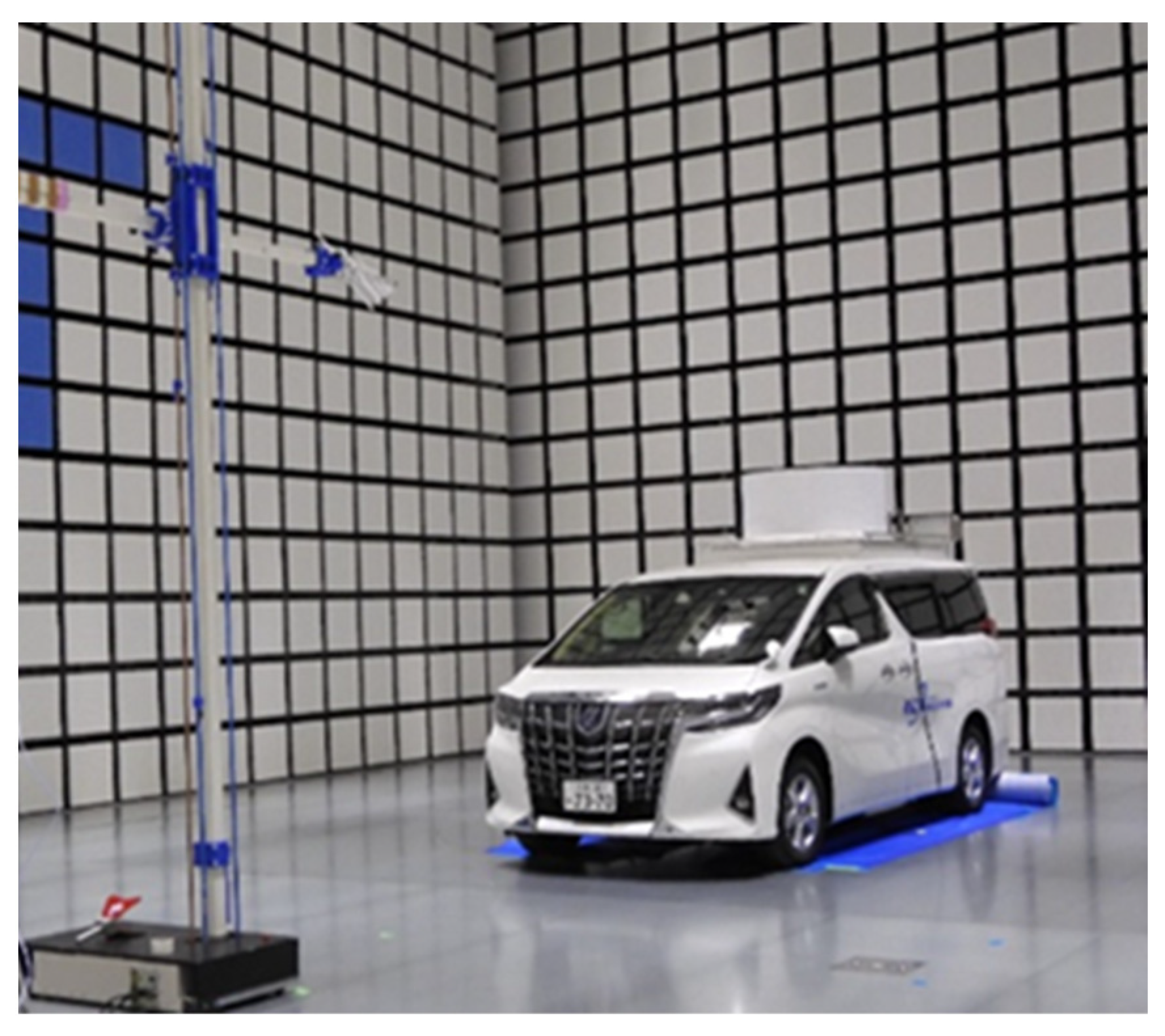
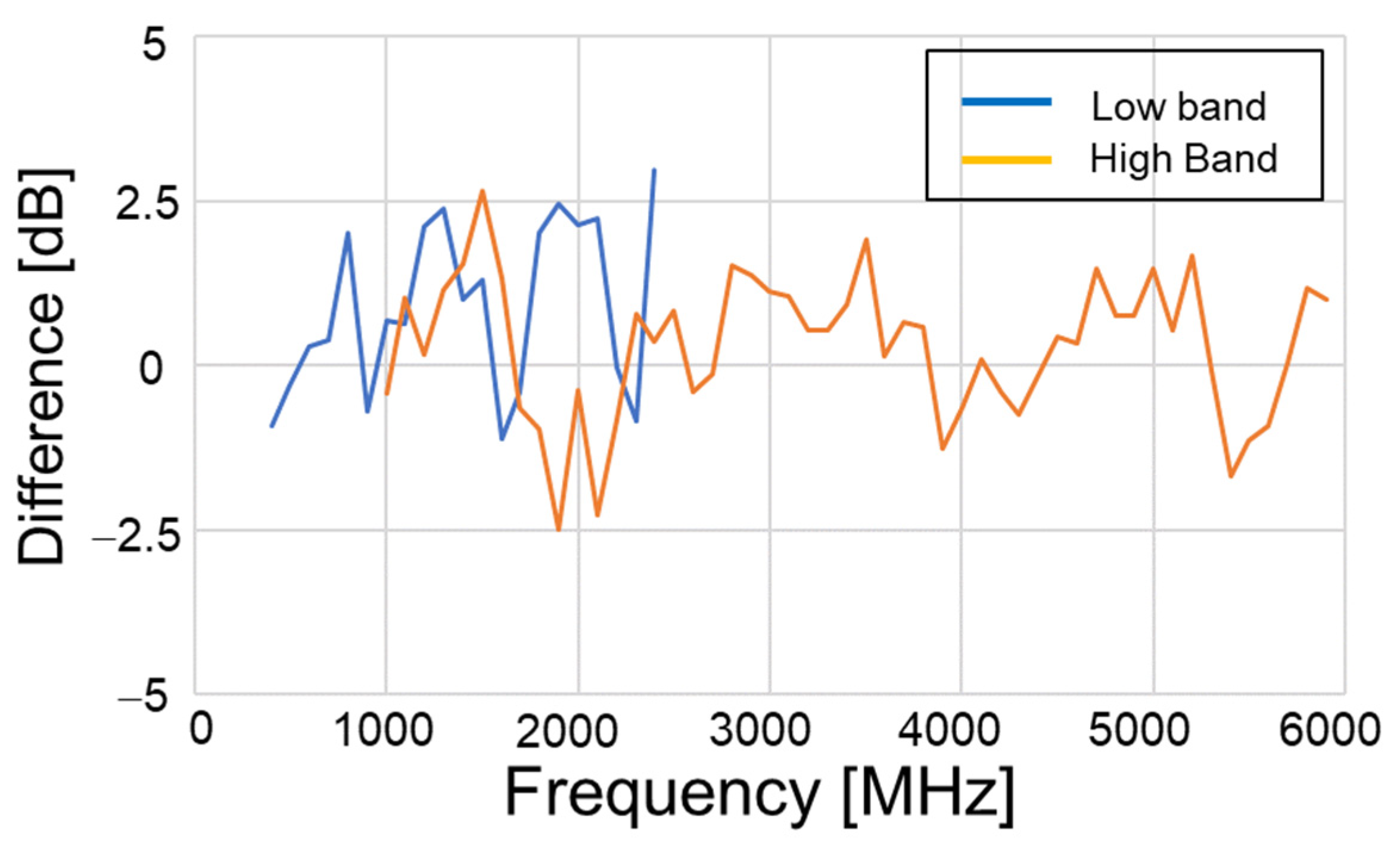
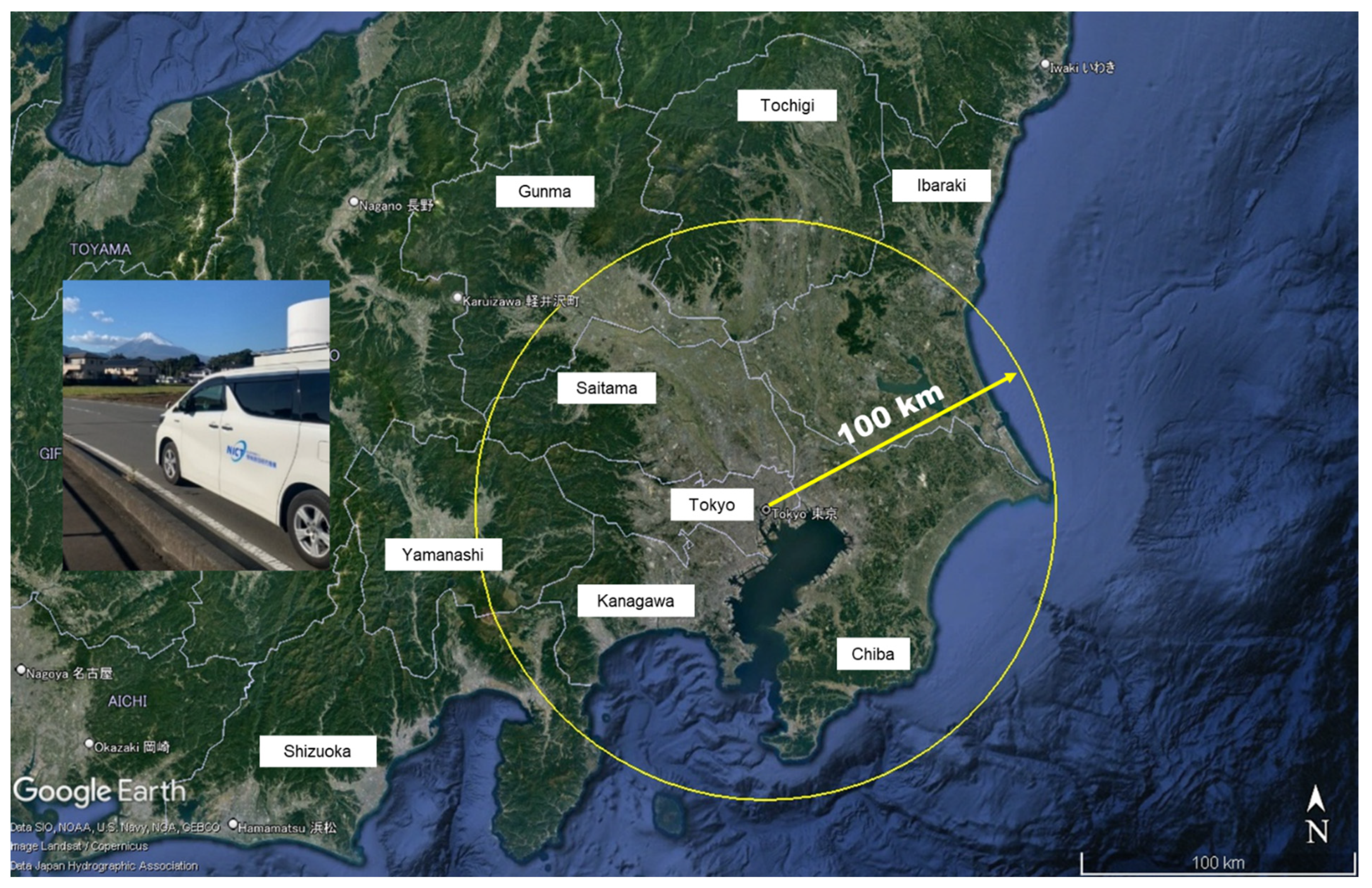

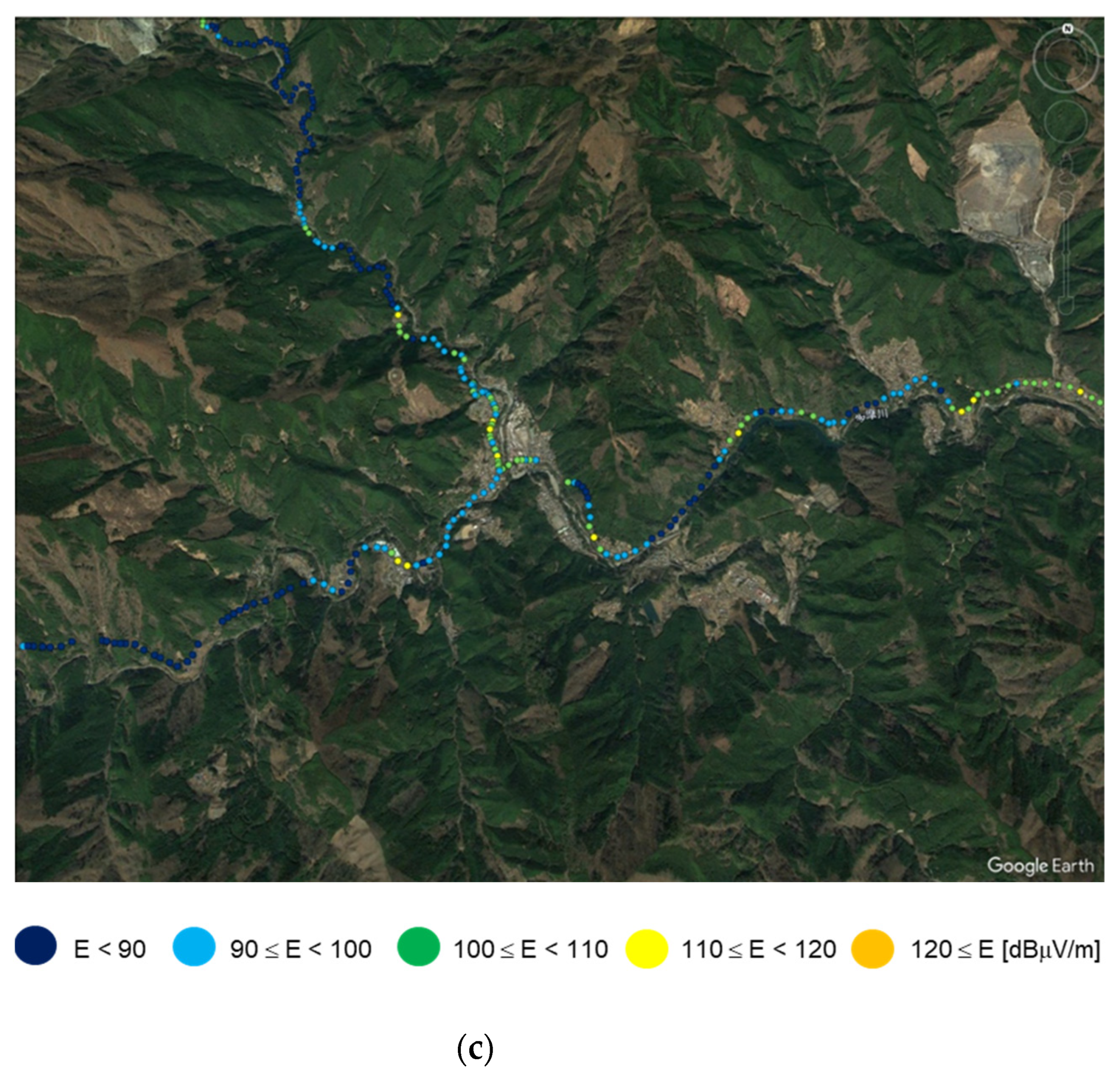
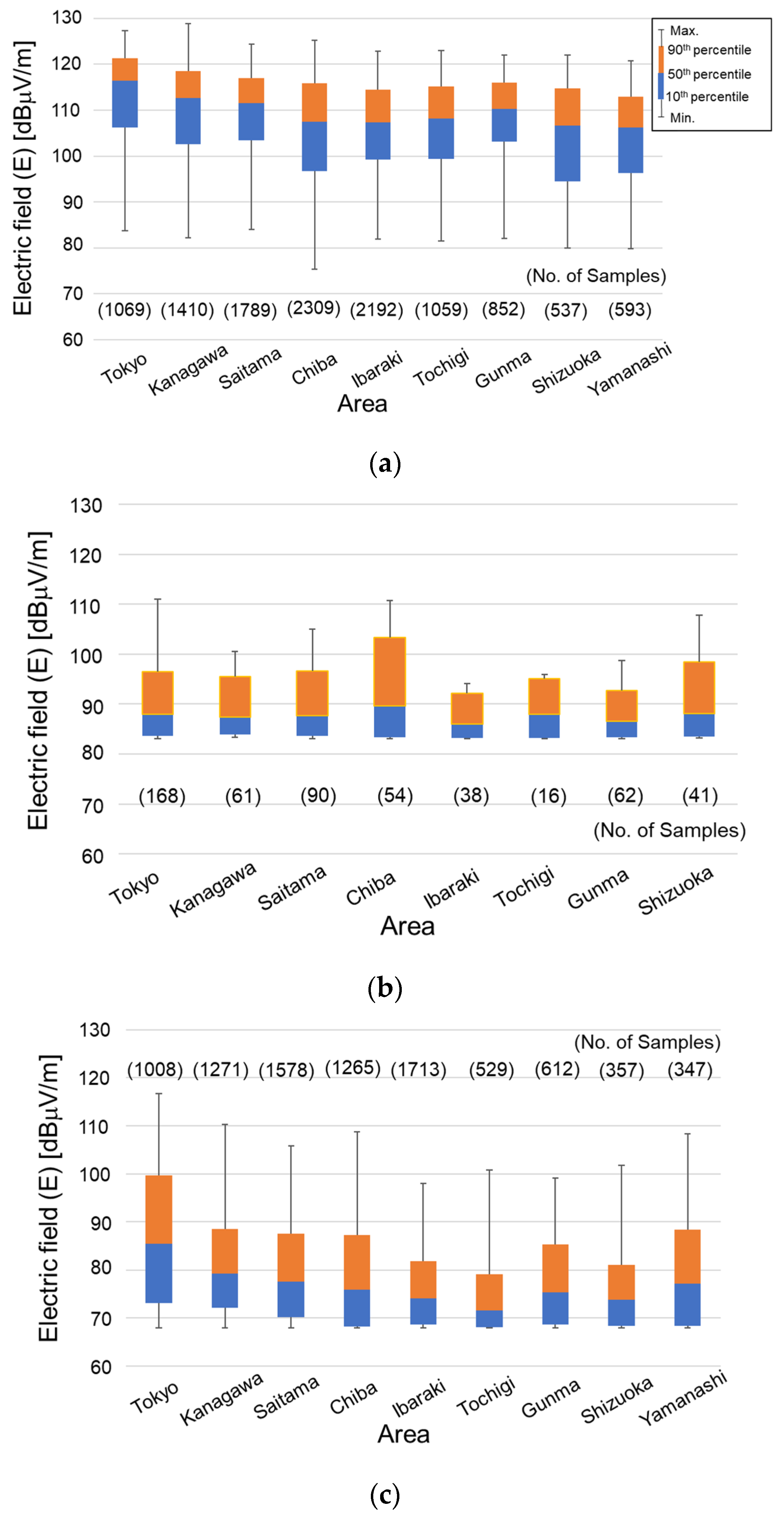

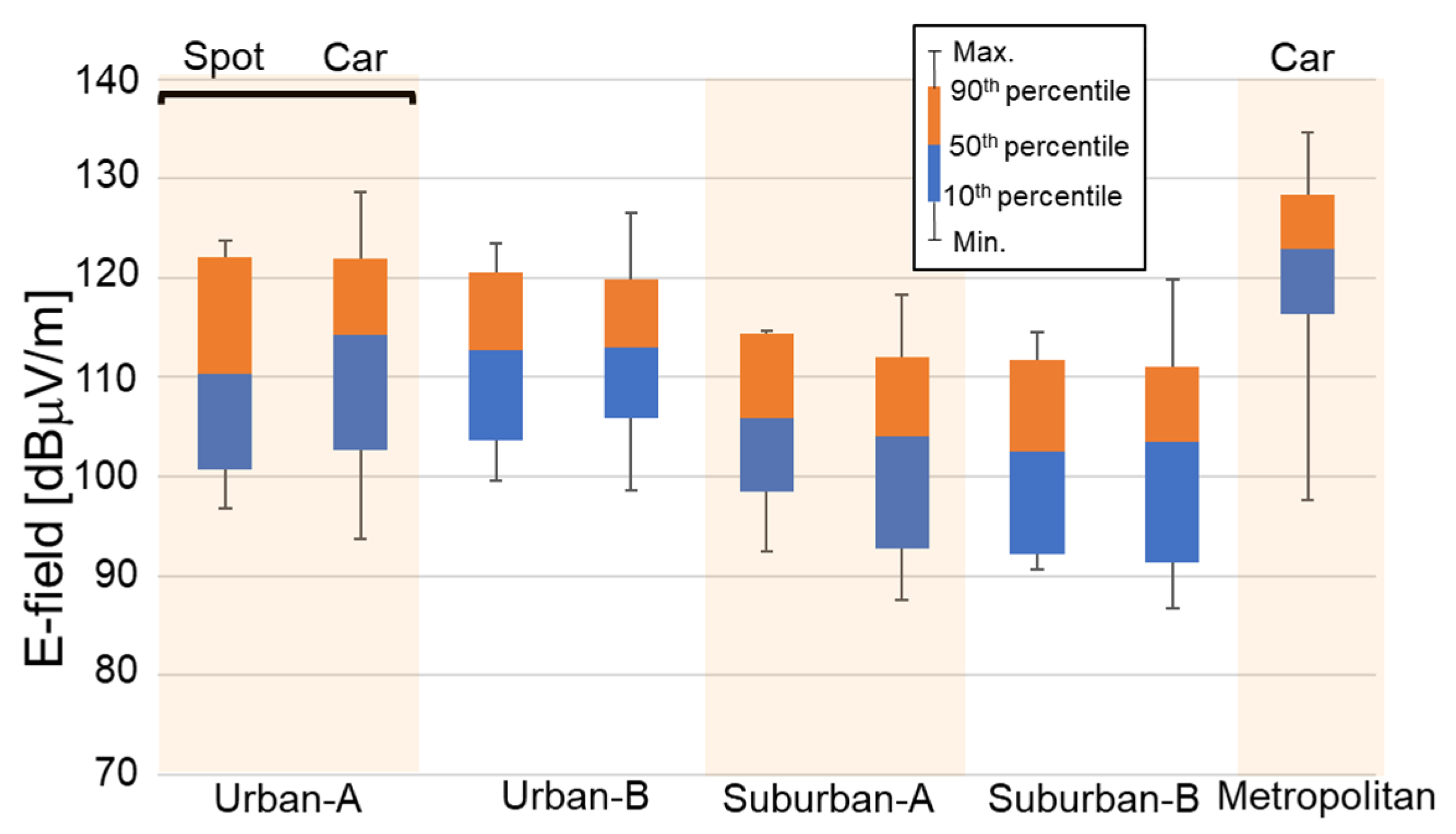

| Name | Frequency Range [MHz] |
|---|---|
| FM | 76–95 |
| TV | 470–710 |
| 700 MHz band | 773–803 |
| 800 MHz band | 860–890 |
| 900 MHz band | 945–960 |
| 1500 MHz band | 1475.9–1510.9 |
| 1700 MHz band | 1805–1880 |
| 1900 MHz band (TDD) | 1884.5–1916.6 |
| 2000 MHz band | 2110–2170 |
| 2400 MHz band | 2400–2497 |
| 2500 MHz band (TDD) | 2545–2645 |
| 3500 MHz band (TDD) | 3400–3600 |
| 3700 MHz band (5G; TDD) | 3600–4100 |
| 4500 MHz band (5G; TDD) | 4500–4600 |
| 4600 MHz band (L5G; TDD) | 4600–4900 |
| 5200 MHz band | 5150–5250 |
| 5300 MHz band | 5250–5350 |
| 5600 MHz band | 5470–5730 |
| Prefecture | Area [km2] | Population [k] |
|---|---|---|
| Tokyo | 2104 | 14,048 |
| Kanagawa | 2416 | 9237 |
| Saitama | 3768 | 7345 |
| Chiba | 5082 | 6284 |
| Ibaraki | 6096 | 2867 |
| Tochigi | 6408 | 1933 |
| Gunma | 6362 | 1939 |
| Shizuoka | 7255 | 3633 |
| Yamanashi | 4201 | 810 |
| Prefecture | Driving Distance for Measurement [km] | Average Driving Speed [km/h] | Mesh Area Coverage [%] | Population Coverage [%] |
|---|---|---|---|---|
| Tokyo | 1580 | 19.3 | 31.3 | 84.1 |
| Kanagawa | 1689 | 22.5 | 40.1 | 85.4 |
| Saitama | 2624 | 25.3 | 33.5 | 77.5 |
| Chiba | 1801 | 30.2 | 33.4 | 62.2 |
| Ibaraki | 2315 | 33.3 | 28.8 | 60.6 |
| Tochigi | 1040 | 31.8 | 14.2 | 53.9 |
| Gunma | 1048 | 27.6 | 11.1 | 63.0 |
| Shizuoka | 902 | 30.0 | 5.8 | 17.4 |
| Yamanashi | 813 | 33.7 | 11.0 | 45.6 |
| Route | Averaged Difference [dB] |
|---|---|
| Route 1 | 0.6 |
| Route 2 | −0.1 |
| Area | Combination | Number of Combinations | Total Number of Valid Measurements | ||
|---|---|---|---|---|---|
| Day | Daytime/ Nighttime | Number of Repetitions per One Condition | |||
| Urban A | Weekdays/ Holidays | Day/Night | 5 | 4 | 78 |
| Suburban A | 80 | ||||
| Metropolitan | 80 | ||||
| Urban B | Day | 40 | |||
| Suburban B | 40 | ||||
| Area | Average Driving Speed [km/h] |
| Urban A | 16.8 |
| Suburban A | 25.4 |
| Metropolitan | 13.6 |
| Urban B | 16.2 |
| Suburban B | 21.9 |
| System | Urban A | Urban B | Suburban A | Suburban B | Metropolitan |
|---|---|---|---|---|---|
| FM | 0.73 | 0.76 | 1.6 | 1.6 | 0.5 |
| TV | 1.7 | 0.88 | 2.3 | 3.0 | 0.6 |
| Mobile | 1.6 | 1.1 | 2.3 | 0.74 | 1.3 |
Disclaimer/Publisher’s Note: The statements, opinions and data contained in all publications are solely those of the individual author(s) and contributor(s) and not of MDPI and/or the editor(s). MDPI and/or the editor(s) disclaim responsibility for any injury to people or property resulting from any ideas, methods, instructions or products referred to in the content. |
© 2023 by the authors. Licensee MDPI, Basel, Switzerland. This article is an open access article distributed under the terms and conditions of the Creative Commons Attribution (CC BY) license (https://creativecommons.org/licenses/by/4.0/).
Share and Cite
Onishi, T.; Esaki, K.; Tobita, K.; Ikuyo, M.; Taki, M.; Watanabe, S. Large-Area Monitoring of Radiofrequency Electromagnetic Field Exposure Levels from Mobile Phone Base Stations and Broadcast Transmission Towers by Car-Mounted Measurements around Tokyo. Electronics 2023, 12, 1835. https://doi.org/10.3390/electronics12081835
Onishi T, Esaki K, Tobita K, Ikuyo M, Taki M, Watanabe S. Large-Area Monitoring of Radiofrequency Electromagnetic Field Exposure Levels from Mobile Phone Base Stations and Broadcast Transmission Towers by Car-Mounted Measurements around Tokyo. Electronics. 2023; 12(8):1835. https://doi.org/10.3390/electronics12081835
Chicago/Turabian StyleOnishi, Teruo, Kaoru Esaki, Kazuhiro Tobita, Miwa Ikuyo, Masao Taki, and Soichi Watanabe. 2023. "Large-Area Monitoring of Radiofrequency Electromagnetic Field Exposure Levels from Mobile Phone Base Stations and Broadcast Transmission Towers by Car-Mounted Measurements around Tokyo" Electronics 12, no. 8: 1835. https://doi.org/10.3390/electronics12081835
APA StyleOnishi, T., Esaki, K., Tobita, K., Ikuyo, M., Taki, M., & Watanabe, S. (2023). Large-Area Monitoring of Radiofrequency Electromagnetic Field Exposure Levels from Mobile Phone Base Stations and Broadcast Transmission Towers by Car-Mounted Measurements around Tokyo. Electronics, 12(8), 1835. https://doi.org/10.3390/electronics12081835






